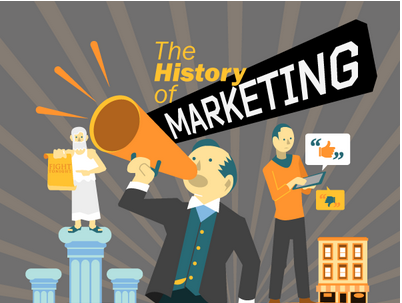If our MBA classes taught us anything, it's that certain marketing concepts never change. Ideas like supply and demand, branding and cost/benefit analysis will always be around in some capacity. However, the marketing function within a small business is anything but static. It has radically evolved in the last 20 years and continues to change as you read this. So today we'd like to look at the evolution of marketing, where it is today, and what it means for small businesses everywhere.
Throughout each phase, one common element is clear: marketers must adapt to new technologies available to them and figure out ways to efficiently reach customers.You see various types of marketing "technologies" and the years they were introduced — magazines in 1741, posters in 1839, and billboards in 1867. However, it isn't until the advent of radio and television that we begin to see traces of what we consider modern marketing techniques. A few decades later, the advent of desktop publishing in 1985 heralded an explosion in print advertising, while the Internet, naturally, emerged as a prime marketing medium in the late 90s.For the purposes of today’s post we'd like to look at the job's evolution through the lens of technology. After all, as technology evolves, so do critical factors like marketing message, spending patterns and perhaps most importantly, customer desire. Hubspot provides a very cool infographic tracking the evolution of marketin g, beginning with the very early days of the printing press, up until the present day.
g, beginning with the very early days of the printing press, up until the present day.
It wasn't until the late 90s, however, that things got a bit more interesting — and complicated. During this time we began to see the diversification of Internet-related marketing, primarily with the rise of search marketing. This led to the emergence of search engine optimization (SEO), PPC advertising, AdWords, email, keyword linking, blogging — well, the list goes on. Ultimately, the takeaway is obvious: beginning in the early 2000s, "online marketing" encompassed a very broad terrain — and that's before the emergence of social media and proliferation of mobile devices!
So where does that leave the marketing executive at a small business in 2014? For starters, as we previously noted, certain principles haven't changed. You'll always have the need for creating buyer personas, for example. But the delivery mechanisms that marketers have to apply these principles and reach customers are many and constantly changing.
What it means, ultimately, is that marketers need to rely less on gut instinct and more on data. They need to understand the true demographic profile of the customers. They need to develop strategies that speak to their needs. Most importantly, they need to create powerful content while leveraging channels that expand their brand and deliver the most bang for their buck, be it email lists, social media posts, blogging, or some sort of combination of each.
In other words, the modern age calls for a transition away from "outbound" marketing — cold-calling, radio, spam, telemarketing — to "inbound marketing" — promoting your brand through unique content, blogs, SEO, social media, etc. It's a profound shift that's upending centuries of traditional marketing practices. It's new, it's unpredictable, and it's here to stay whether you like it or not, so you may as well jump on board.






